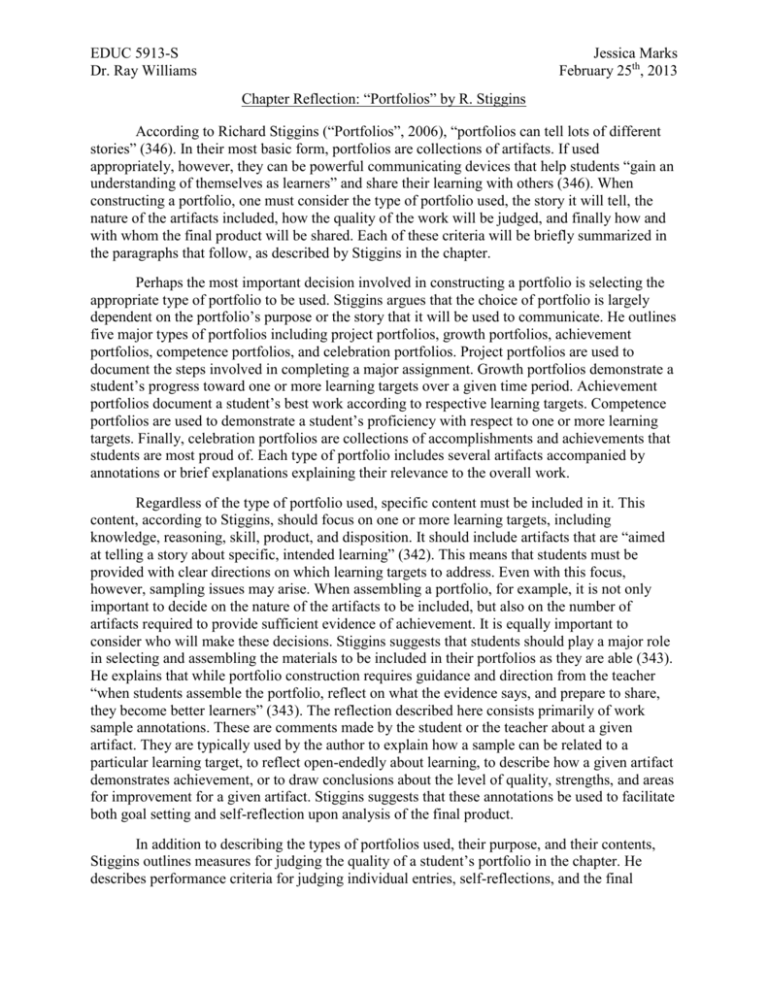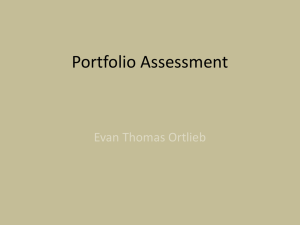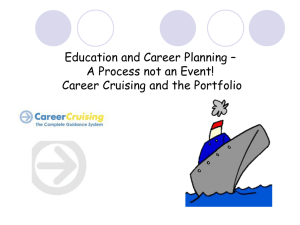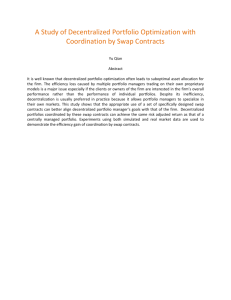"Portfolios" - R. Stiggins
advertisement

EDUC 5913-S Dr. Ray Williams Jessica Marks February 25th, 2013 Chapter Reflection: “Portfolios” by R. Stiggins According to Richard Stiggins (“Portfolios”, 2006), “portfolios can tell lots of different stories” (346). In their most basic form, portfolios are collections of artifacts. If used appropriately, however, they can be powerful communicating devices that help students “gain an understanding of themselves as learners” and share their learning with others (346). When constructing a portfolio, one must consider the type of portfolio used, the story it will tell, the nature of the artifacts included, how the quality of the work will be judged, and finally how and with whom the final product will be shared. Each of these criteria will be briefly summarized in the paragraphs that follow, as described by Stiggins in the chapter. Perhaps the most important decision involved in constructing a portfolio is selecting the appropriate type of portfolio to be used. Stiggins argues that the choice of portfolio is largely dependent on the portfolio’s purpose or the story that it will be used to communicate. He outlines five major types of portfolios including project portfolios, growth portfolios, achievement portfolios, competence portfolios, and celebration portfolios. Project portfolios are used to document the steps involved in completing a major assignment. Growth portfolios demonstrate a student’s progress toward one or more learning targets over a given time period. Achievement portfolios document a student’s best work according to respective learning targets. Competence portfolios are used to demonstrate a student’s proficiency with respect to one or more learning targets. Finally, celebration portfolios are collections of accomplishments and achievements that students are most proud of. Each type of portfolio includes several artifacts accompanied by annotations or brief explanations explaining their relevance to the overall work. Regardless of the type of portfolio used, specific content must be included in it. This content, according to Stiggins, should focus on one or more learning targets, including knowledge, reasoning, skill, product, and disposition. It should include artifacts that are “aimed at telling a story about specific, intended learning” (342). This means that students must be provided with clear directions on which learning targets to address. Even with this focus, however, sampling issues may arise. When assembling a portfolio, for example, it is not only important to decide on the nature of the artifacts to be included, but also on the number of artifacts required to provide sufficient evidence of achievement. It is equally important to consider who will make these decisions. Stiggins suggests that students should play a major role in selecting and assembling the materials to be included in their portfolios as they are able (343). He explains that while portfolio construction requires guidance and direction from the teacher “when students assemble the portfolio, reflect on what the evidence says, and prepare to share, they become better learners” (343). The reflection described here consists primarily of work sample annotations. These are comments made by the student or the teacher about a given artifact. They are typically used by the author to explain how a sample can be related to a particular learning target, to reflect open-endedly about learning, to describe how a given artifact demonstrates achievement, or to draw conclusions about the level of quality, strengths, and areas for improvement for a given artifact. Stiggins suggests that these annotations be used to facilitate both goal setting and self-reflection upon analysis of the final product. In addition to describing the types of portfolios used, their purpose, and their contents, Stiggins outlines measures for judging the quality of a student’s portfolio in the chapter. He describes performance criteria for judging individual entries, self-reflections, and the final product and emphasizes the fact that such judgments should be formative in nature. In order to judge the quality of individual artifacts, Stiggins recommends creating a rubric that defines various levels of quality as they pertain to a given learning target (348). He suggests using a similar method to judge the quality of students’ self-reflections, and of the final product, again putting the emphasis on the formative nature of this task. When it comes to determining the audience with whom the portfolio will be shared, Stiggins recommends first reflecting on the purpose of the portfolio. In some cases, a portfolio’s audience may be its creator, but in others, it can be used to communicate student learning to parents, other students, teachers, administrators, community members, potential employers, etc. Regardless of the audience, Stiggins argues, the process of sharing a portfolio with others enhances students’ learning (349). To summarize the contents of the chapter, Stiggins presents four key issues that contribute to the success of a portfolio. He explains that the quality of a portfolio is only as good as the quality of its contents and thus the nature of student assignments must coincide with the learning targets to be included in the portfolio. He recommends keeping track of students’ progress and periodically scheduling time for students to select and annotate artifacts. He provides strategies for identifying artifacts, and gives ideas on how these artifacts can be organized and stored while the portfolio is being constructed. He highlights the importance of taking time to review the purpose and process of portfolio construction upfront by outlining criteria for individual entries, self reflection, and the portfolio as a whole. Finally, he explains that having students publicly display their learning to others requires a pre-established classroom environment that is both safe and respectful. In summary, “the real power of portfolios is in the opportunities they provide students to analyze, summarize, and reflect on their learning” (355). In order for portfolios to be most effective, Stiggins recommends that students be involved in selecting the content that is included in them, provide commentary on this content, and reflect on what they have learned by completing this process. Only when these three conditions are satisfied will the construction of a portfolio be worth the investment (355). Stiggins, R., Arter, J. Chappuis, J. & Chappuis, S. (2006). Portfolios. Classroom Assessment for Student Learning : Doing it Right – Using it Well. Educational Testing Services: Portland OR, 353-359.







